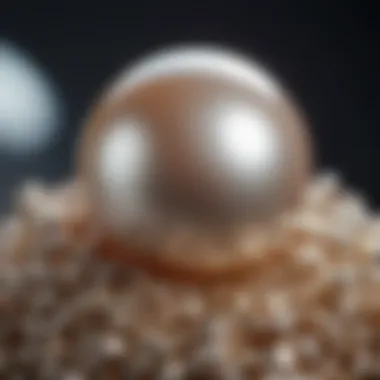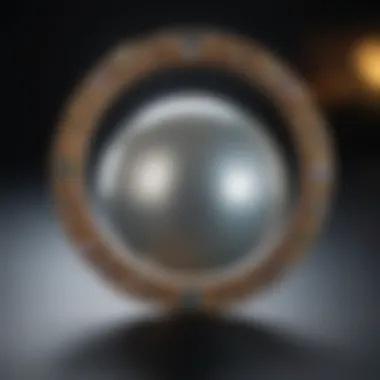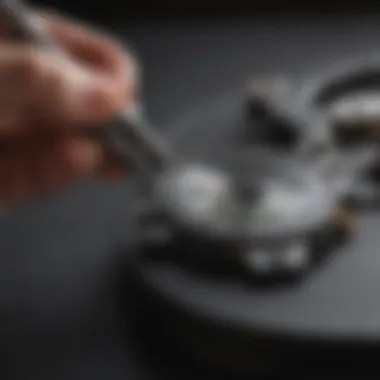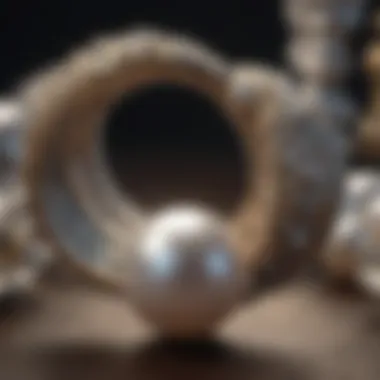Unveiling the Authenticity: Deciphering Real vs. Fake Pearls


Overview of Pearls and Gemstones
Pearls hold a unique allure, distinct from other gemstones, owing to their organic origin. Unlike minerals, which form within the Earth's crust, pearls are created by living organisms like oysters and mussels. Throughout history, pearls have been treasured for their iridescent beauty and association with luxury and sophistication. Cultures around the world have revered pearls for centuries, considering them symbols of purity and elegance.
Characteristics of Genuine Pearls
To distinguish real pearls from their counterfeit counterparts, one must understand the key characteristics inherent to authentic pearls. Genuine pearls, formed naturally within mollusks, possess distinct properties that set them apart. These properties include a smooth, lustrous surface created by layers of nacre, a substance secreted by the mollusk as a defense mechanism. Genuine pearls also exhibit slight variations in shape, size, and color, reflecting their organic formation process.
The Tell-Tale Signs of Fake Pearls
Counterfeit pearls, often crafted from glass or plastic, lack the natural sheen and warmth of genuine pearls. Fake pearls may have a visibly uniform surface, devoid of the subtle irregularities characteristic of authentic pearls. Additionally, conducting a simple tooth test can help reveal the authenticity of a pearl - genuine pearls feel gritty when rubbed against the teeth, while fake pearls remain smooth. By carefully examining these distinguishing features, one can effectively identify fake pearls and make informed purchasing decisions.
The Value and Rarity of Pearls
The value of pearls is determined by various factors, such as size, shape, color, surface quality, and luster. Pearls with exceptional clarity, symmetry, and a deep, reflective luster are highly coveted and command premium prices in the market. Moreover, the rarity of certain types of pearls, such as natural pearls found in the wild or cultured pearls of exceptional quality, further adds to their desirability and value.
Determining Pearl Authenticity
Various methods, including X-ray examination and surface magnification, can aid in verifying the authenticity of pearls. X-ray imaging helps reveal the internal structure of a pearl, confirming whether it contains concentric layers of nacre indicative of natural formation. Surface magnification allows for a close inspection of a pearl's surface, enabling the detection of irregularities or imperfections that are telltale signs of fake pearls. By combining these evaluation techniques, one can confidently ascertain the authenticity of pearls and make well-informed purchasing decisions.
Caring for Your Precious Pearls
Proper care and maintenance are essential to preserve the beauty and value of pearls over time. To maintain their luster and longevity, pearls should be stored separately from other jewelry items to prevent scratching. Additionally, pearls are sensitive to chemicals, perfumes, and harsh detergents, necessitating gentle cleaning using a soft cloth and mild soap. By adhering to these care practices, one can ensure that their pearls retain their exquisite charm and radiance for generations to come.
Introduction
Pearls, those exquisite jewels of the sea, have fascinated humankind for centuries with their iridescent beauty and timeless elegance. As coveted gemstones, pearls carry a mystique that captivates gemstone enthusiasts, collectors, jewelry designers, and geology enthusiasts alike. The allure of pearls lies not only in their aesthetic glamour but also in their status as natural treasures. This article embarks on a journey into the realm of pearls, dissecting the intricate art of distinguishing between authentic pearls and their counterfeit counterparts.
In a world inundated with imitation goods, the ability to verify the authenticity of pearls holds paramount importance for connoisseurs and buyers seeking genuine quality. By unraveling the nuances of identifying real pearls from fake ones, this article aims to equip readers with invaluable knowledge, fostering confident decision-making in pearl acquisition. Understanding the distinguishing features and authentication techniques of pearls not only safeguards investments but also deepens appreciation for these organic gems.


From exploring the formation processes that give rise to pearls to uncovering the key indicators of quality and worth, this insightful guide permeates every facet of the pearl authentication journey. By scrutinizing luster, surface quality, shape, and size as pivotal determinants, readers will discern the multifaceted considerations integral to differentiating authentic pearls.
Moreover, the journey into determining pearl authenticity extends beyond mere visual assessments, incorporating tactile examinations and specialized weight tests to validate the genuineness of each pearl. Delving into common authenticity tests like the tooth test, grit test, and even X-ray inspection unveils the meticulous procedures involved in scrutinizing pearls with precision.
As the curtain rises on this comprehensive guide, readers proceed to explore the invaluable role of consulting experts in authenticating pearls with unwavering accuracy. By engaging with knowledgeable professionals, individuals gain access to expert insights and specialized tools that elevate the authenticity verification process to new heights.
Join us in unraveling the secrets of the ocean's treasures, demystifying the realm of pearls, and embarking on a journey that celebrates authenticity, beauty, and the enduring legacy of these precious gems.
Understanding Pearls
Understanding pearls is a fundamental aspect when it comes to determining their authenticity. As treasured gemstones, pearls hold a significant allure for enthusiasts, collectors, jewelry designers, and geology enthusiasts. This section dissects the various elements that define pearls, shedding light on the intricacies of their formation, the diverse types available, and the essential factors that contribute to their value.
Formation of Pearls
Pearl formation is a fascinating process rooted in nature's intricate mechanisms. When an irritant such as a grain of sand infiltrates the soft tissue of a mollusk, the organism secretes layers of nacre to coat the intruder gradually. Over time, these layers compact to form the luminous orb we recognize as a pearl. This organic creation process gives pearls their unique essence and character, making each one a work of natural art. Understanding the formation of pearls is crucial in distinguishing genuine pearls from synthetic ones.
Types of Pearls
The realm of pearls encompasses a diverse array of types, each with its distinct origins and characteristics. From classic saltwater pearls like Akoya and South Sea pearls to the iridescent freshwater pearls, the variety is extensive. Understanding the nuances of each type, such as their culturing conditions, colors, shapes, and sizes, plays a vital role in differentiating between real and counterfeit pearls. Exploring the spectrum of pearl types offers a deeper appreciation for these mesmerizing gemstones.
Value Factors
The value of a pearl is influenced by a multitude of factors that determine its rarity, quality, and desirability. Factors such as size, shape, surface quality, luster, and color all contribute to a pearl's overall value. Understanding the significance of these factors aids in assessing the authenticity and value of pearls accurately. By delving into the intricate details of value factors, enthusiasts can make informed decisions when acquiring pearls, ensuring a discerning and gratifying purchase.
Physical Characteristics
In this section of the article, we delve deep into the realm of physical characteristics and their paramount importance in determining the authenticity of pearls. Understanding the physical aspects of pearls is crucial for gemstone enthusiasts and collectors alike. The physical characteristics encompass various elements that provide vital insights into the quality and value of pearls.
One of the key aspects under physical characteristics is the luster of pearls. The luster refers to the shine and glow exhibited by pearls when exposed to light. High-quality pearls will possess a deep, mirror-like luster that reflects light beautifully, adding to their allure and value. By examining the luster of a pearl, one can often discern between real and fake pearls.


Another significant factor within physical characteristics is surface quality. The surface quality of pearls involves examining the texture, smoothness, and imperfections present on the surface of the pearl. Genuine pearls typically display a surface that is free from blemishes and imperfections, whereas fake pearls might exhibit inconsistencies or irregularities. Analyzing the surface quality is essential in authenticating pearls.
Moreover, the shape and size of pearls form an integral part of their physical characteristics. Pearls come in various shapes such as round, oval, button, and baroque, with each shape carrying its unique appeal. The size of pearls also plays a crucial role in determining their value, with larger pearls often commanding higher prices. Understanding the significance of shape and size is essential in evaluating the authenticity and quality of pearls.
Luster
Luster plays a pivotal role in distinguishing between real and fake pearls. The luster of a pearl refers to its shine and how effectively it reflects light. High-quality pearls boast a rich, radiant luster that sets them apart from imitations. To identify authentic pearls, look for a deep, luminous luster that emanates elegance and sophistication.
Surface Quality
Surface quality is a crucial factor in determining the authenticity of pearls. Genuine pearls exhibit a flawless surface, devoid of imperfections such as bumps, cracks, or peeling. By carefully examining the surface quality of pearls, one can uncover valuable insights into their authenticity. Counterfeit pearls often lack the smooth, pristine surface characteristic of genuine pearls.
Shape and Size
The shape and size of pearls offer valuable clues about their authenticity and quality. Round pearls are considered highly desirable and are typically associated with premium quality. Moreover, larger pearls tend to be rarer and more valuable than smaller ones. By assessing the shape and size of pearls, one can make informed decisions regarding their authenticity and determine their worth.
Examination Techniques
Examination techniques play a pivotal role in the process of determining the authenticity of pearls, a complex yet crucial task. Accurate examination methods are essential for gem enthusiasts, collectors, and jewelry designers seeking to differentiate between genuine pearls and counterfeit replicas. In this article, we will delve into various methods and tools utilized in the examination of pearls, shedding light on the intricate details that signify the authenticity of these prized gemstones. By understanding and mastering these examination techniques, readers can ensure informed decision-making when acquiring pearls.
Visual Inspection
Visual inspection serves as the initial step in examining pearls, allowing for a detailed assessment of the gem's surface characteristics. The luster, color, and surface quality are meticulously observed during this process. Authentic pearls exhibit a deep, iridescent luster that reflects light elegantly, showcasing their natural beauty. Additionally, variations in color and surface imperfections can provide valuable insights into the authenticity of a pearl. Gemstone enthusiasts can discern real pearls from fakes by closely examining these visual cues, honing their ability to differentiate between the two.
Touch and Feel
The tactile experience of touching and feeling pearls offers gemstone enthusiasts a unique perspective on their authenticity. Genuine pearls possess a distinct surface texture that is cool to the touch and may exhibit slight irregularities. In contrast, fake pearls often feel unnaturally smooth and uniform, lacking the organic texture of their authentic counterparts. By engaging in a sensory exploration of pearls through touch, individuals can gain valuable insights into their genuineness, enhancing their ability to identify and appreciate these precious gemstones.
Weight Test


Conducting a weight test is another essential technique for assessing the authenticity of pearls. Authentic pearls typically have a significant weight to them due to their formation process and composition. By comparing the weight of a suspected pearl to that of a known genuine pearl, gemstone enthusiasts can discern discrepancies that may indicate a counterfeit item. This method, although requiring precision and accuracy, can serve as a valuable tool in the arsenal of examination techniques, assisting individuals in making informed decisions when evaluating pearls for authenticity.
Common Tests for Authenticity
Determining the authenticity of pearls through common tests is crucial for buyers and collectors. These tests play a significant role in distinguishing genuine pearls from counterfeit ones, ensuring that one makes informed decisions when purchasing these exquisite gems. By conducting these tests, individuals can verify the quality and value of pearls before making a significant investment. The common tests for authenticity outlined in this article will cover various aspects such as visual appearance, surface properties, and internal structure, shedding light on the key indicators of authenticity and quality in pearls.
Tooth Test
The tooth test is a traditional method used to assess the authenticity of pearls. By gently running the pearl against the biting edge of a tooth, experts can evaluate its texture and surface characteristics. Genuine pearls typically feel slightly gritty, while fake ones may feel unnaturally smooth. This test relies on the fact that pearls have microscopic layers that create a rough texture, unlike synthetic pearls that lack this natural graininess. The tooth test offers a quick and practical way to preliminarily determine the authenticity of pearls in a non-invasive manner, making it a popular choice among jewelry enthusiasts and collectors seeking authentic pieces.
Girt Test
The grit test is another important method for determining pearl authenticity. This test involves rubbing two pearls against each other to assess their surface quality. Genuine pearls exhibit slight resistance when rubbed together, emitting a faint powdery residue due to the friction between their layers. In contrast, fake pearls often feel smoother and may produce no residue, highlighting their synthetic nature. By performing the grit test, experts can identify the presence of natural nacre in pearls, a key characteristic that influences their value and authenticity.
X-ray Examination
X-ray examination is a sophisticated technique used to examine the internal structure of pearls without causing any damage to their delicate surface. By subjecting pearls to X-ray imaging, gemologists can visualize the layers of nacre and detect any potential irregularities or foreign substances within the pearls. Genuine pearls typically display concentric ring patterns and uniform structures when viewed under X-ray, indicating their natural origin. In contrast, fake pearls may show inconsistencies or homogenous structures that reveal their artificial composition. X-ray examination provides a detailed insight into the composition and quality of pearls, offering a reliable method for verifying their authenticity and determining their value in the market.
Consulting Experts
Consulting experts plays a crucial role when determining the authenticity of pearls. Considering the intricate nature of pearls and the expertise required to identify genuine specimens, consulting with professionals in the field becomes paramount. Experts bring a wealth of knowledge and experience, honed through years of working with pearls of varying origins and qualities. Their trained eye can discern subtle differences that escape the untrained observer, providing valuable insights into the nuances of pearl authentication. By tapping into their expertise, enthusiasts and collectors can receive accurate assessments and guidance on distinguishing between real and fake pearls.
Engaging with experts offers several benefits when navigating the complex world of pearls. These specialists possess a deep understanding of pearl cultivation, production methods, and the unique characteristics of different pearl types. Their in-depth knowledge allows them to evaluate pearls based on comprehensive criteria, including luster, surface quality, shape, and size, enabling them to make informed judgments regarding authenticity. Additionally, experts are familiar with the latest developments in pearl treatments and enhancements, ensuring that buyers are aware of any alterations that may affect a pearl's value.
Moreover, consulting experts provides an opportunity for enthusiasts to deepen their appreciation and knowledge of pearls. These professionals often share intriguing insights into the history of pearls, cultural significance, and industry trends, enriching the overall buying and collecting experience. Through interactions with experts, individuals can enhance their ability to discern quality pearls, identify potential red flags indicating artificial treatments, and gain a more profound insight into the factors influencing pearl pricing and market trends.
When seeking guidance from experts, it is essential to consider certain factors to ensure a fruitful collaboration. Choosing reputable and certified professionals with a proven track record in the gem and jewelry industry is vital to obtaining accurate and reliable information. Additionally, enthusiasts should communicate their preferences, concerns, and budget constraints clearly to experts, allowing them to tailor their recommendations accordingly. By fostering open communication and establishing a rapport with experts, individuals can benefit maximally from the wealth of expertise these professionals offer in the realm of pearls.
Conclusion
Understanding the authenticity of pearls holds immense significance within the realms of gemstone knowledge and fine jewelry appreciation. This article meticulously unravels the complexities surrounding the identification of real and fake pearls, catering to the interests of discerning individuals committed to making informed decisions in their acquisitions. The conclusive section serves as a beacon of knowledge for gemstone enthusiasts, collectors, jewelry designers, and geology aficionados, encapsulating a wealth of insights to aid in differentiating genuine pearls from their counterfeit counterparts.
By delving deep into the intricacies of pearl evaluation, readers embark on a journey towards mastering the art of discerning quality jewels. Through a meticulous examination of luster, surface quality, shape, and size, individuals can hone their expertise, distinguishing premium pearls from inferior replicas with confidence and precision. The emphasis on visual inspection, tactile assessments, and weight tests ensures a comprehensive evaluation process that leaves no stone unturned in the pursuit of authenticity.
Furthermore, the inclusion of common tests such as the tooth test, grit test, and X-ray examination equips readers with practical methodologies to verify the legitimacy of pearls, instilling a sense of assurance in their purchasing decisions. Consulting experts emerges as a vital aspect in enhancing one's understanding of pearls, offering invaluable insights and guidance based on years of experience and specialized knowledge.







